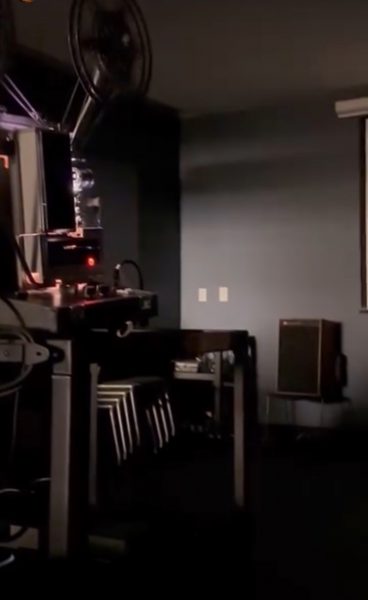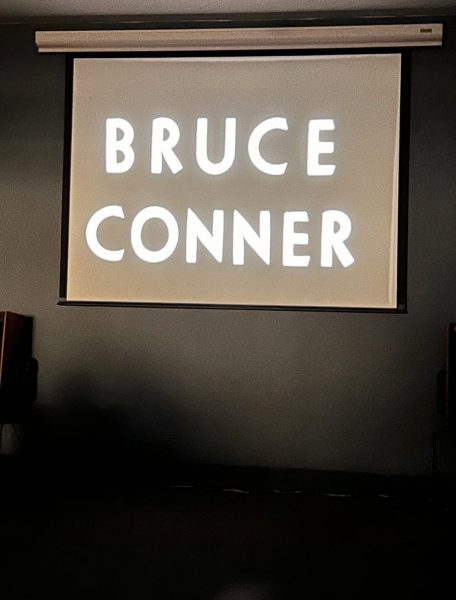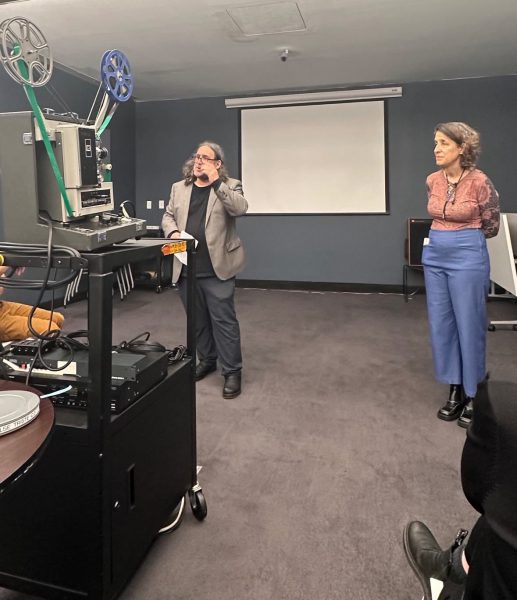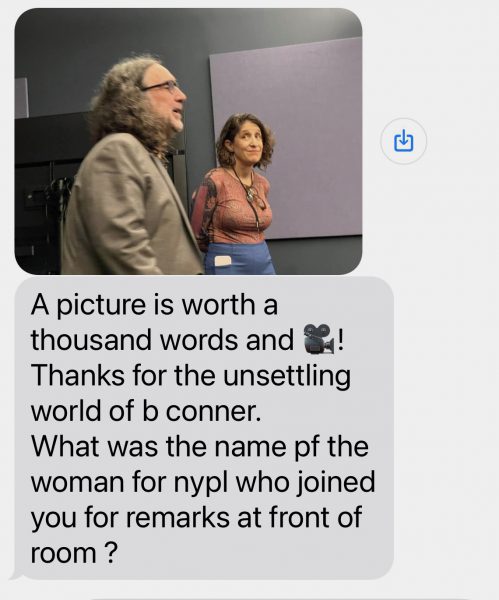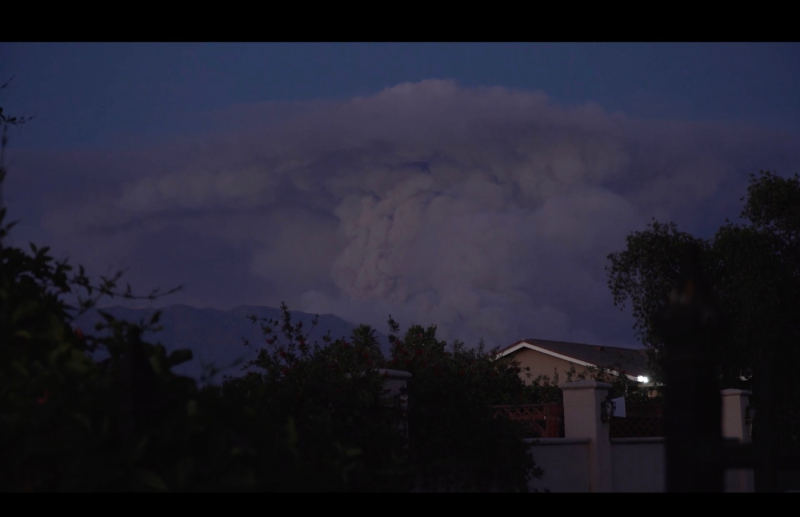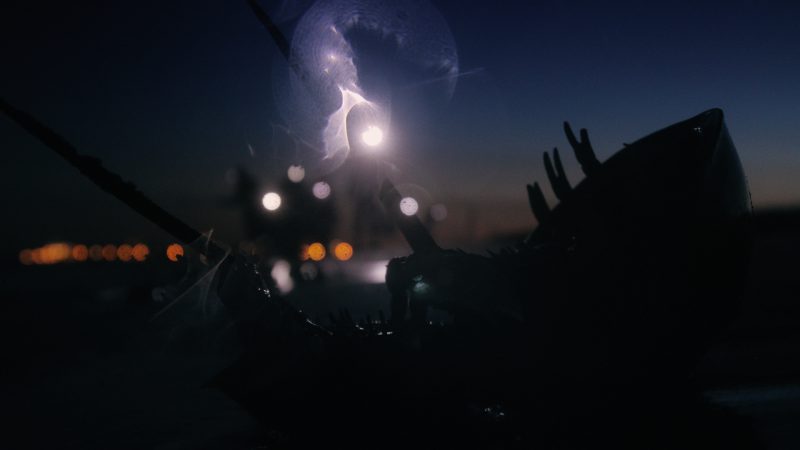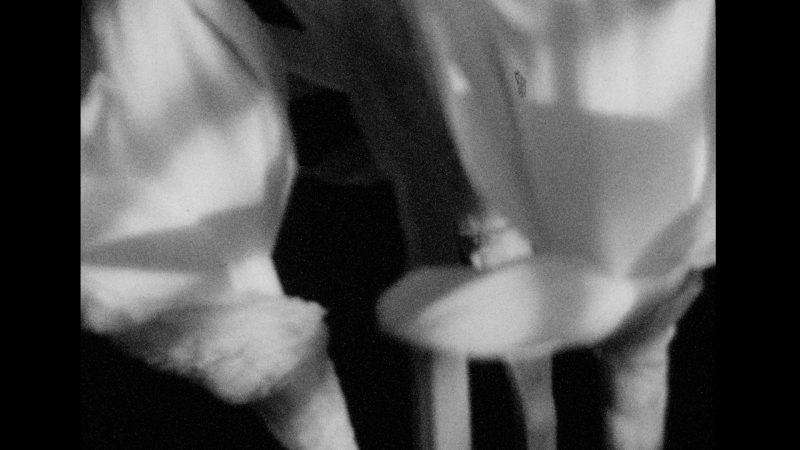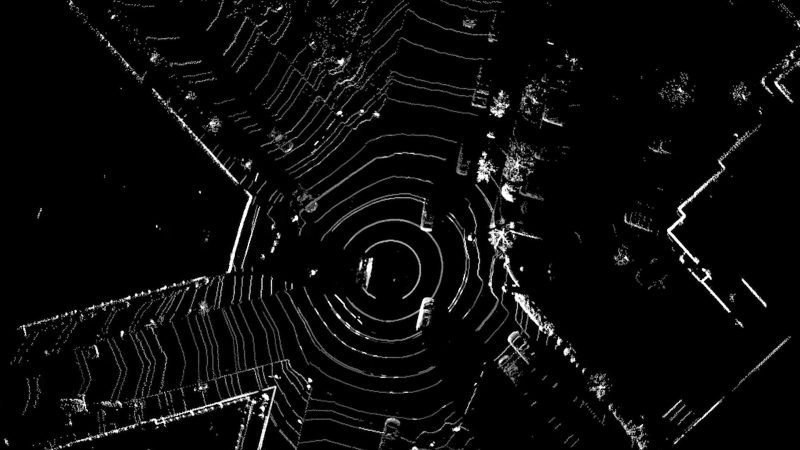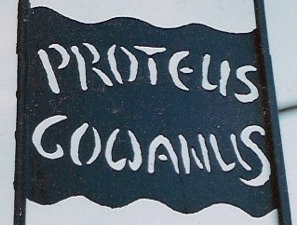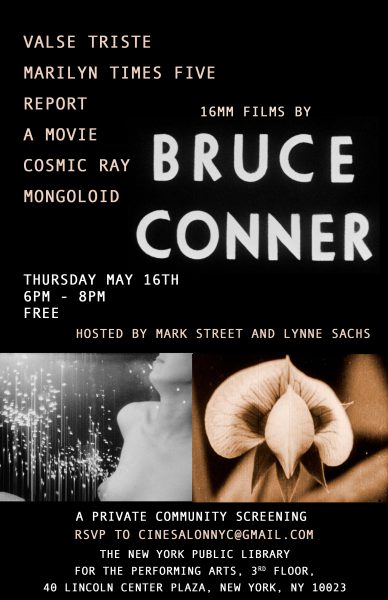
Join us at the New York Public Library for the Performing Arts for a free invite-only screening of six 16mm prints of films by provocateur, collagist and found-footage whiz BRUCE CONNER. Hosted by New York filmmakers Mark Street and Lynne Sachs (XY Chromosome Project).
Thursday, May 16, 2024
6 – 8 PM (doors open at 5:30, limited seating)
40 Lincoln Center Plaza
Film Study Center, 3rd Floor | Free
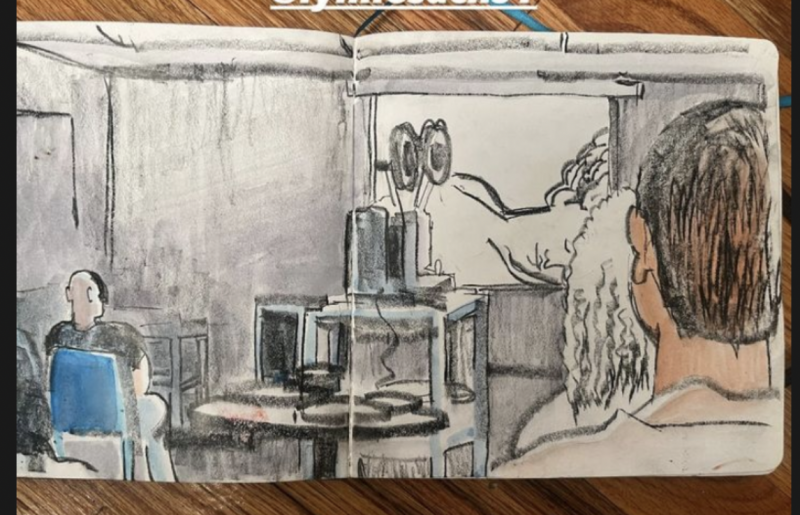
Street and Sachs first met in San Francisco in the late 1980s when Bruce Conner’s aura as an avant-garde filmmaker was legendary. They both watched everything he’d made, including “A Movie”, his brazen, sardonic salute to the detritus of popular culture and were smitten. “Report” is a kick in the gut, an indictment of media saturation, and a surprisingly elegiac commentary on the Kennedy assassination. “Valse Triste” moves beyond irony to create a dream-like tender world of the imagination. “Marilyn Times Five” pushes all our buttons, simultaneously titillating and infuriating the feminist in both of us. “Mongoloid” pre-curses the MTV era and stands as one of the first rock videos ever made. “Cosmic Ray” animates a Ray Charles tune with a witty mélange of unexpected recycled images. Please join us for this evening in celebration of the work of film artist Bruce Conner, an adept dumpster-diver into the trashcan of history!
All are welcome. Please RSVP to cinesalonnyc@gmail.com.
LYNNE’S NOTES
My background as Bruce’s intern in 1985:
Trying to re-splice his films.
Driving him around SF in his Cadillac convertible to look for geiger counters to buy – fear of radioactivity
Love of gospel music
Lunch
Fear of dying
My children’s birth
Helping him interpret highbrow texts on his work
Story of MoMA show
His attendance at premiere of Sermons and Sacred Pictures
A MOVIE
1958, 16mm, b&w/sound, 12min.
Music by Ottorino Respighi “Pines of Rome” (Pini di Roma)
“… a montage of found materials from fact (newsreels) and fiction (old movies). Cliches and horrors make a rapid collage in which destruction and sex follow each other in images of pursuit and falling until finally a diver disappears through a hole in the bottom of the sea – the ultimate exit. The entire thing is prefaced by a girl from a shady movie lazily undressing. By the time A MOVIE is over she has retrospectively become a Circe or Prime Mover.” – Brian O’Doherty, The New York Times” Using only found footage, Conner has created one of the most extraordinary films ever made. One begins by laughing at the juxtaposition of cowboys and Indians, elephants and tanks, but soon the metaphor of association becomes serious, as we realize we are witnessing the apocalypse.” – Freude
REPORT
1963-1967, 16mm, b&w/sound, 13min.
Soundtrack: “Four Days That Shocked The World” (1963)
“Society thrives on violence, destruction, and death no matter how hard we try to hide it with immaculately clean offices, the worship of modern science, or the creation of instant martyrs. From the bullfight arena to the nuclear arena we clamor for the spectacle of destruction. The crucial link in REPORT is that JFK with his great PT 109 was just as much a part of the destruction game as anyone else. Losing is a big part of playing games.”
– David Mosen, Film Quarterly
“Conner is the most brilliant film-editor of the avant-garde. In REPORT he has used newsreel footage and radio tapes of President Kennedy’s assassination to produce a thirteen minute movie that captures unbearably, yet exhilaratingly, the tragic absurdity of that day.”
– Jack Kroll, Newsweek
VALSE TRISTE
1978, 16mm, sepia/sound, 5min.
“VALSE TRISTE is frankly and gracefully autobiographical of Conner’s Kansas boyhood. Here, the period of the 1940s of his source materials parallels his own life experiences.” A line of dark, wet cars file across a flooded road; a man and a boy ceremoniously burn leaves; a businessman at his desk turns to look over his shoulder to the photo of a locomotive on the wall behind him; a medium shot of an engineer in the cab of his locomotive; a shard of rock shears from a quarry wall and plunges into water …”
– Anthony Reveaux
Nostalgic recreation of dreamland Kansas 1947 in Toto. Theme music from I Love a Mystery radio programs (Jack, Doc, and Reggie confront the enigmatic lines of railroad trains, sheep, black cars, women exercising in an open field, grandma at the farm …) Meanwhile, a 13-year-old boy confronts reality. Sibelius grows old in Finland and becomes a national monument.
MARILYN TIMES FIVE
1968-1973, 16mm, b&w/sound, 13.5min.
With Arline Hunter
“A young woman, allegedly Marilyn Monroe, is seen with pitiless scrutiny in the arena of an old girlie film. The reiteration of five cycles rotates the commodity of her moon-pale body as her song repeats five times on the sound track … ‘I’m through with love.’ The last shot terminates a final reward of stillness as she is seen crumpled on the floor.”
– Anthony Reveaux
The image, or Anima, of Marilyn Monroe was not owned by Norma Jean any more than it was owned by Arline Hunter. Images can sometimes have more power than the person they represent. Some cultures consider that an image steals the soul or spirit of the person depicted. They will dwindle and die. MARILYN TIMES FIVE is an equation not intended to be completed by the film alone. The viewer completes the equation.
MONGOLOID
1978, 16mm, b&w/sound, 3.5min.
Music by DEVO “Mongoloid”
A documentary film exploring the manner in which a determined young man overcame a basic mental defect and became a useful member of society. Insightful editing techniques reveal the dreams, ideals and problems that face a large segment of the American male population. Educational. Background music written and performed by the DEVO orchestra.
Mongoloid he was a mongoloid, happier than you and me.
Mongoloid he was a mongoloid, and it determined what he could see.
Mongoloid he was a mongoloid, one chromosome too many.
And he wore a hat, and he had a job
And he brought home the bacon so that no one knew
COSMIC RAY
1961, 16mm, b&w/sound, 4.5min.
Music by Ray Charles “What’d I Say” Live from Atlanta (1959)
“COSMIC RAY seems like a reckless collage of fast moving parts: comic strips, dancing girls, flashing lights. It is the dancing girl – hardly dressed, stripping or nude – which provides the leitmotiv for the film. Again and again she appears – sandwiched between soldiers, guns, and even death in the form of a skull positioned between her legs. And if the statement equates sex with destruction, the cataclysm is a brilliant one, like an exploding firecracker, and one which ends the world with a cosmic bang. Of course, the title also refers to musician Ray Charles whose art Conner visually transcribes onto film as a potent reality, tough and penetrating in its ability to affect some pretty basic animal instincts. But if such is the content of the film – that much of our behavior consists of bestiality – the work as a whole stands as insight rather than indictment.”
– Carl Belz, Film Culture

